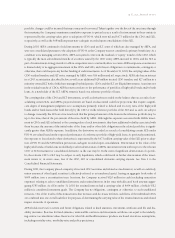American Express 2003 Annual Report Download - page 70
Download and view the complete annual report
Please find page 70 of the 2003 American Express annual report below. You can navigate through the pages in the report by either clicking on the pages listed below, or by using the keyword search tool below to find specific information within the annual report.
(p.68_axp_ financial review)
Separate account assets represent funds held for the exclusive benefit of variable annuity and variable life insurance con-
tract holders. These assets are generally carried at market value, and separate account liabilities are equal to separate account
assets. AEFA earns investment management, administration and other fees from the related accounts. Separate account
assets increased in 2003 due to market appreciation, an additional $2.6 billion of assets from the Threadneedle acquisition
and net inflows.
The National Association of Insurance Commissioners (NAIC) has prescribed Risk-Based Capital (RBC) requirements for
insurance companies. The RBC requirements are to be used as minimum capital and surplus requirements by the NAIC
and state insurance regulators to identify companies that merit further regulatory attention. At December 31, 2003, each of
AEFA’s insurance companies had adjusted capital and surplus in excess of amounts requiring such attention.
State insurance statutes also contain limitations as to the amount of dividends and distributions that insurers may make
without providing prior notification to state regulators. For IDS Life, any dividends or distributions in 2004, whose amount,
together with that of other distributions made within the preceding 12 months, exceeds IDS Life’s 2003 statutory net gain
from operations, would require notification to the Minnesota Commissioner of Commerce who would have the option to
disapprove the proposed distribution based on consideration of general solvency as well as RBC results.
Contingent Liquidity Planning
AEFA has developed a contingent funding plan that enables it to meet daily customer obligations during periods in which
its customers do not roll over maturing certificate contracts and elect to withdraw funds from their annuity and insurance
contracts. This plan is designed to ensure that AEFA could meet these customer withdrawals by selling or obtaining financ-
ing, through repurchase agreements, of portions of its investment securities portfolio.
AEFA received a $564 million capital contribution from the Parent Company for purposes of the September 30, 2003
Threadneedle acquisition, as mentioned earlier.
Risk Management
At AEFA, interest rate exposures arise primarily within its insurance and investment certificate subsidiaries. Rates credited
to customers’ accounts generally reset at shorter intervals than the yield on underlying investments. Therefore, AEFA’s inter-
est spread margins are affected by changes in the general level of interest rates. The extent to which the level of rates affects
spread margins is managed primarily by a combination of modifying the maturity structure of the investment portfolio and
entering into swaps or other derivative instruments that effectively lengthen the rate reset interval on customer liabilities.
Interest rate derivatives with notional amounts totaling approximately $3.9 billion were outstanding at December 31, 2003
to hedge interest rate exposures. Additionally, AEFA has entered into interest rate swaptions with notional amounts total-
ing $1.2 billion to hedge the impact of increasing interest rates on forecasted fixed annuity sales.
The negative effect on AEFA’s pretax earnings of a 100 basis point increase in interest rates, which assumes repricings and
customer behavior based on the application of proprietary models, to the book of business at December 31, 2003 and 2002
would be approximately $53 million and $20 million for 2003 and 2002 (including the impact of minority interest expense
related to the joint venture with AEB), respectively.
AEFA has two primary exposures to the general level of equity markets. One exposure is that AEFA earns fees from the man-
agement of equity securities in variable annuities, variable insurance, proprietary mutual funds and other managed assets.
The amount of fees is generally based on the value of the portfolios, and thus is subject to fluctuation with the general level
of equity market values. To reduce the sensitivity of AEFA’s fee revenues to the general performance of equity markets, AEFA
has from time to time entered into various combinations of financial instruments that mitigate the negative effect on fees
that would result from a decline in the equity markets. The second exposure is that AEFA writes and purchases index options
to manage the margin related to certain investment certificate and annuity products that pay interest based upon the rela-
tive change in a major stock market index between the beginning and end of the product’s term. At December 31, 2003,
equity-based derivatives with a net notional amount of $264 million were outstanding to hedge equity market exposures.
























